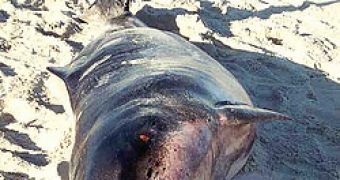Real cases of people saved from drowning by dolphins are known from ancient Greek and Roman stories to the legends of the Polynesians and Maori of the New Zealand. There were cases of dolphins which defended shipwrecked people swimming in the water from shark attacks, till rescue ships appeared. But this behavior is a time record ever: Moko, a New Zealand bottlenose dolphin, saved two stranded pigmy sperm whales (Kogia).
"Before Moko arrived, rescue workers had been working for more than an hour to get two pygmy sperm whales, a mother and her calf, back out to sea after they were stranded Monday off Mahia Beach. The pygmy sperm whales had repeatedly beached, and both they and the humans were tired and set to give up, he said," said co-rescuer Malcolm Smith of the New Zealand Conservation Department.
"The whales restranded themselves four times on a sandbar slightly out to sea from the beach, about 300 miles (500 kilometers) northeast of the capital, Wellington. It was looking likely they would have to be euthanized to prevent a prolonged death. They kept getting disorientated and stranding again. They obviously couldn't find their way back past (the sandbar) to the sea," he added.
When Moko appeared, it approached the whales, communicated with them and lead them 180 m (600 ft ) away along the beach and through a channel out to the open sea.
"Moko just came flying through the water and pushed in between us and the whales. She got them to head toward the hill, where the channel is," Juanita Symes, another rescuer, told the AP.
"I don't speak whale and I don't speak dolphin but there was obviously something that went on because the two whales changed their attitude from being quite distressed to following the dolphin quite willingly and directly along the beach and straight out to sea," Smith told BBC News.
Altruistic dolphins
Dolphins have a great capacity for altruistic activities. Sometimes, they carried people more than 20 mi (32 km) to the shore or protected them from shark attacks. In other cases, dolphins guided fishermen lost in the mist or shipwrecked people found in boats to the shore. But dolphins do not save only people.
Sometimes their behavior seems curious: in a Florida aquarium, dolphins helped a sick shark to breathe, by pushing it to the water surface: this way they killed the shark, even if this would have helped a sick dolphin (or a shipwrecked human). The friendly relationship in some cases between dolphins and fishermen is well-known: the dolphins urge the fish to the fishermen's nets and this eases their own hunting.
The case of the "Pelorus Jack" is a famous one: between 1887 and 1912, a dolphin helped ships cross safely the Cook Strait, between the two main islands of the New Zealand, which are dangerous due to submarine rocks and currents. Dolphins are used to detect sinked ships down to 300 m (1,000 ft) and make connection with divers at 180 m (600 ft), bringing drugs or tools. The dolphin makes that distance 7 times faster than a diver.
It is curious that the dolphins never attack humans, even if just a fluke blow or bite would be enough. They can even attach to some humans. But their excessive hunting (like the infamous Japanese dolphin hunt), overfishing and massive development of the navigation deplete many populations.

 14 DAY TRIAL //
14 DAY TRIAL //